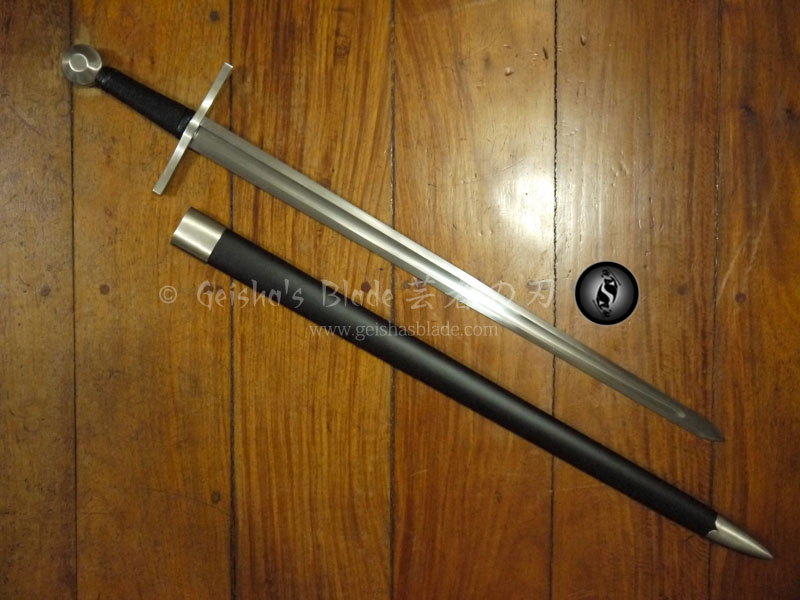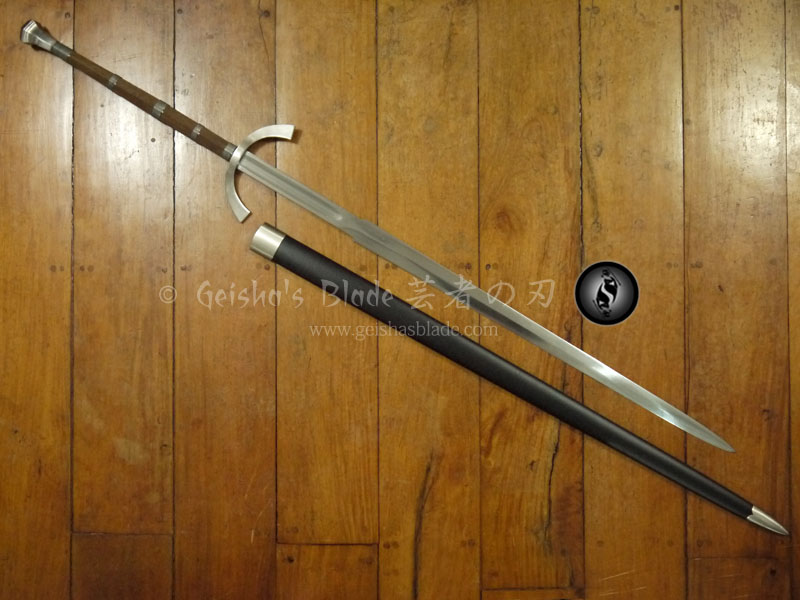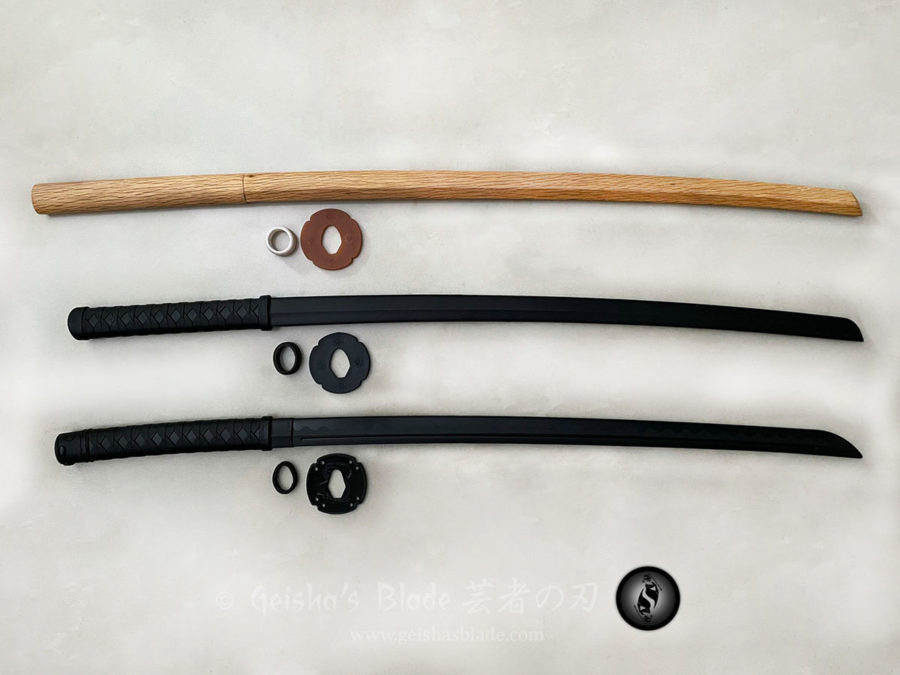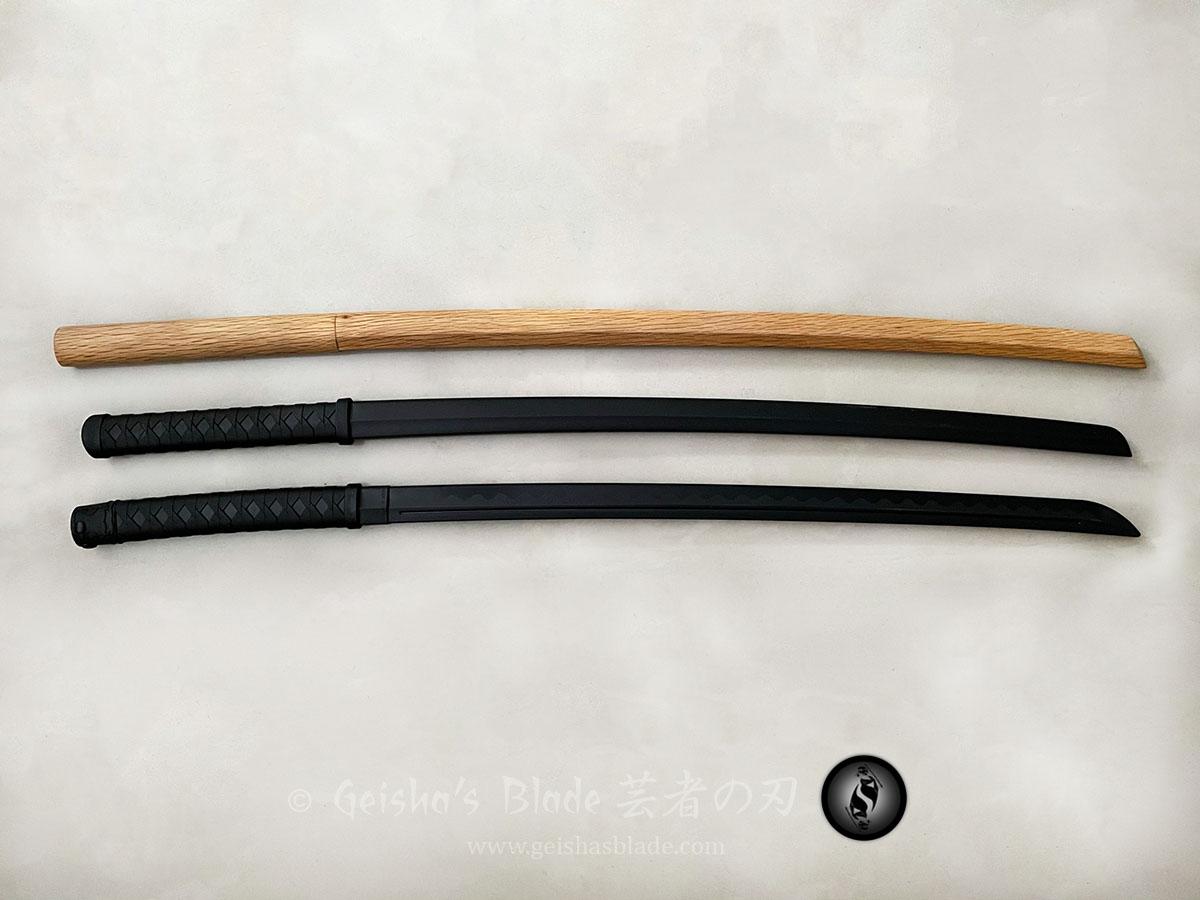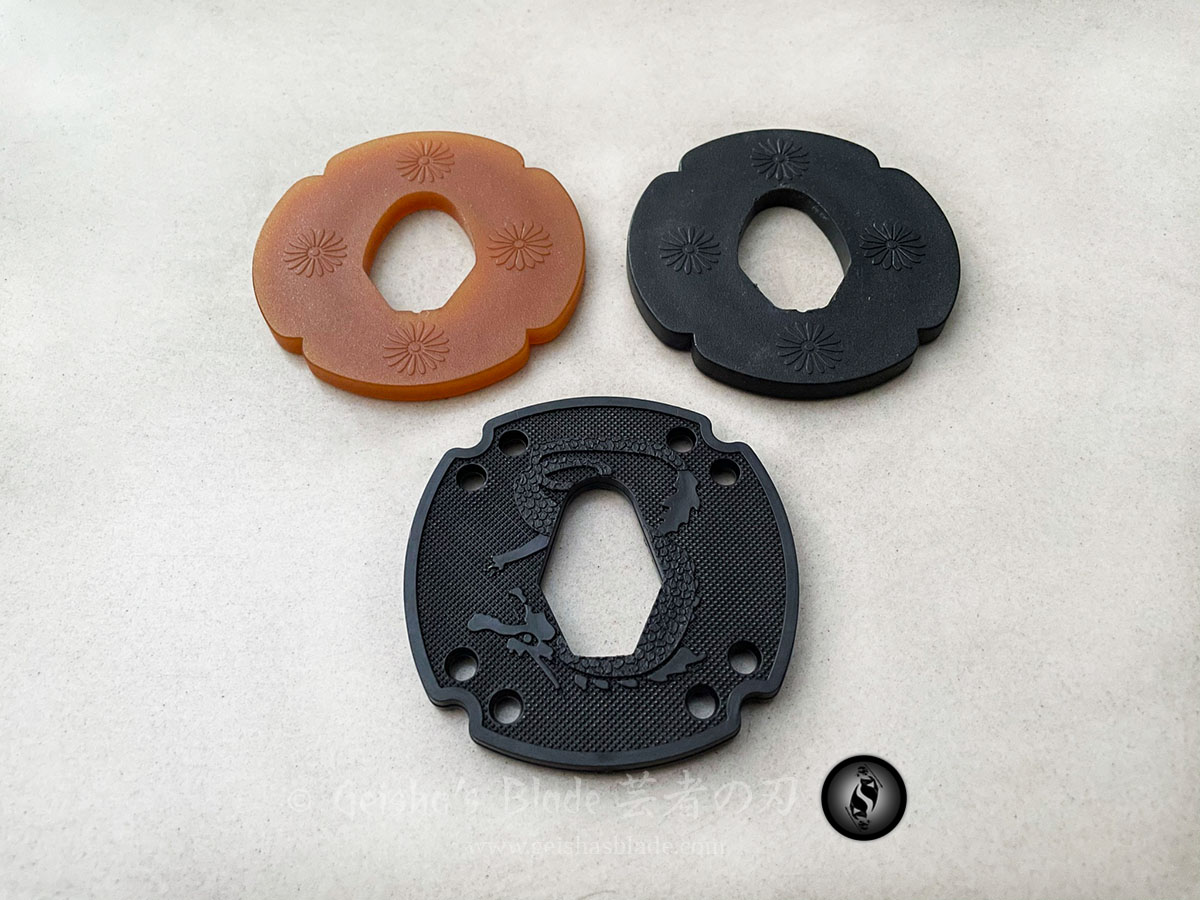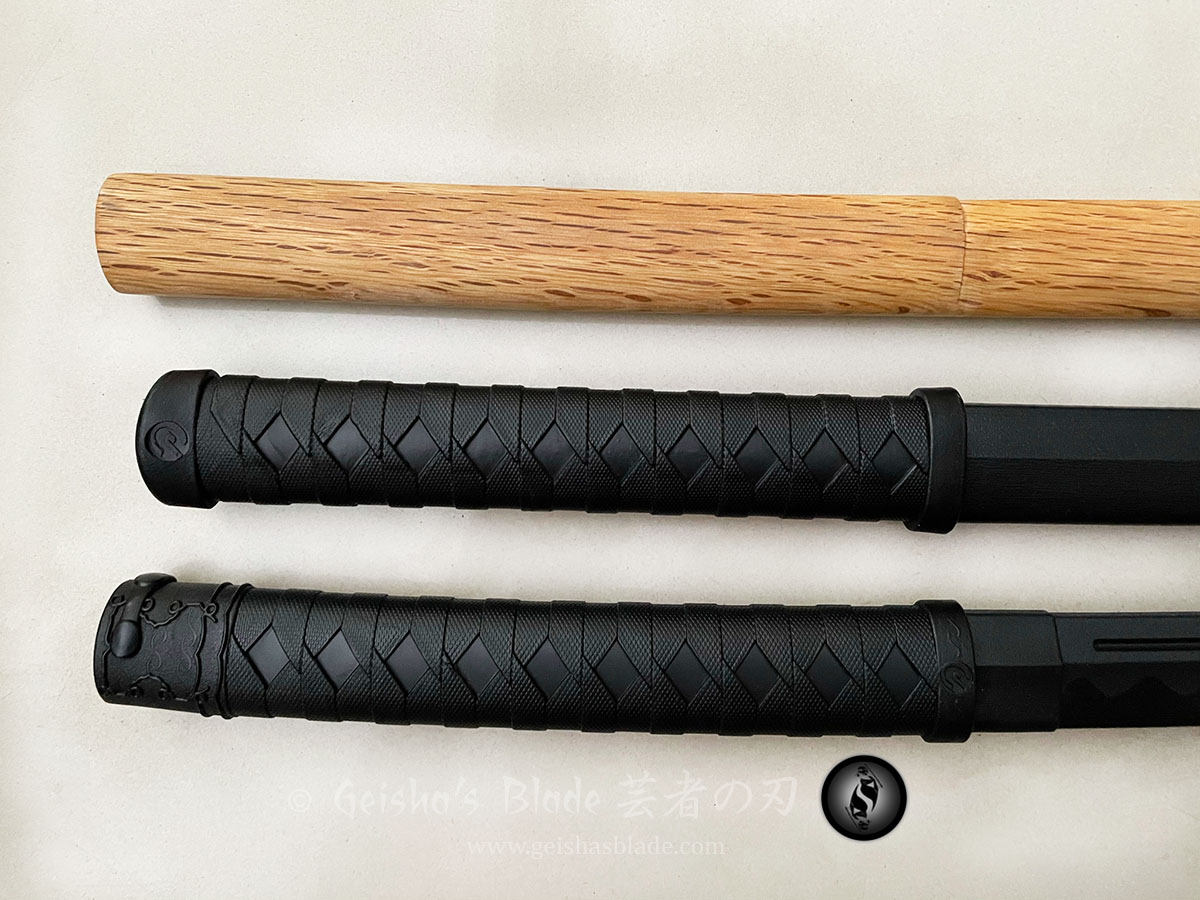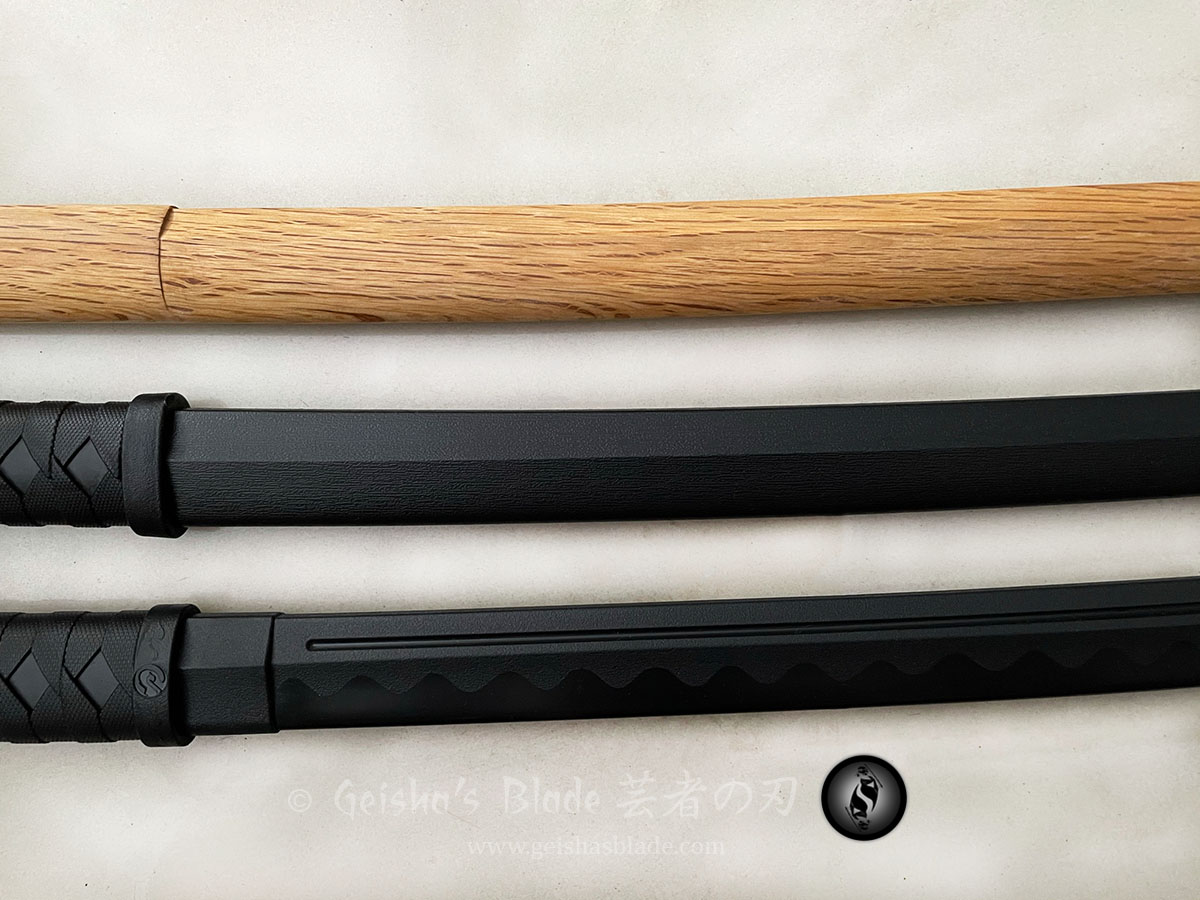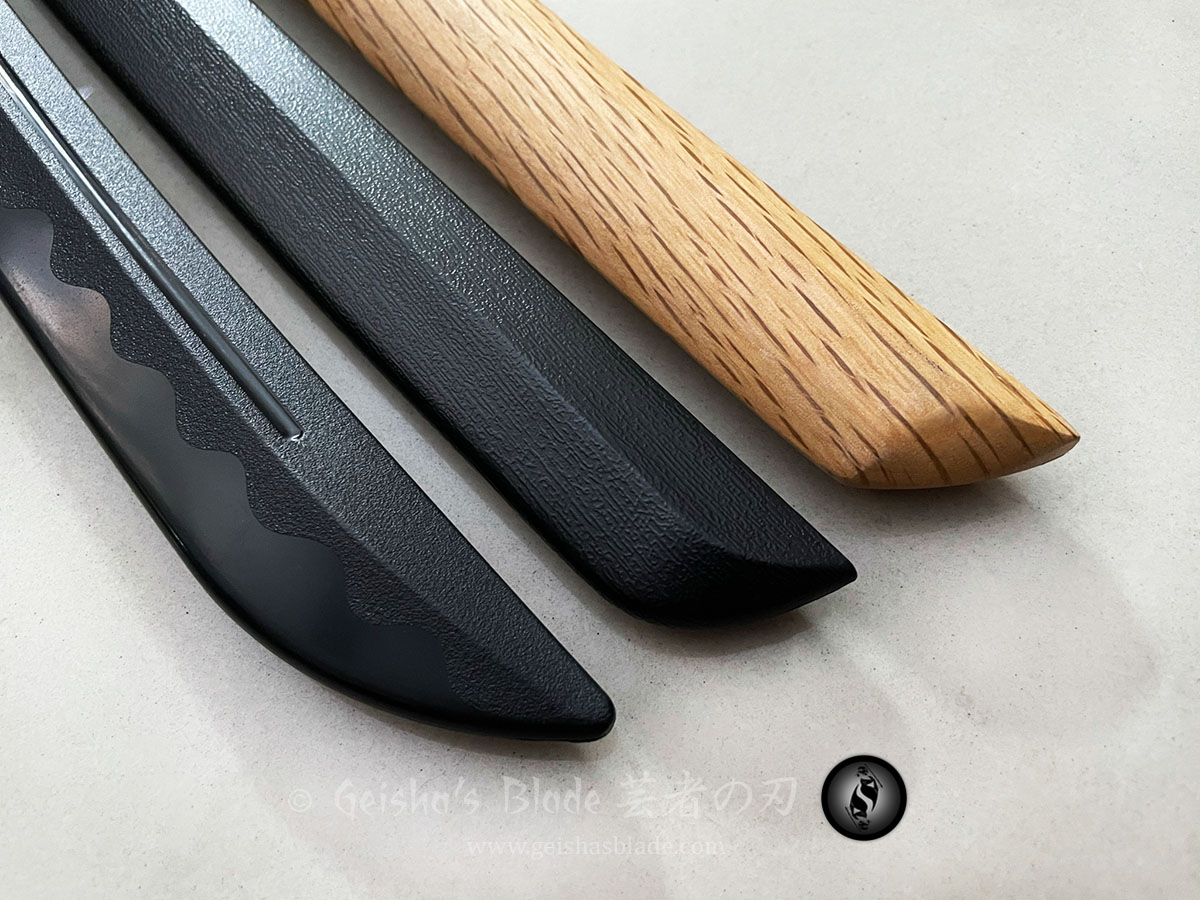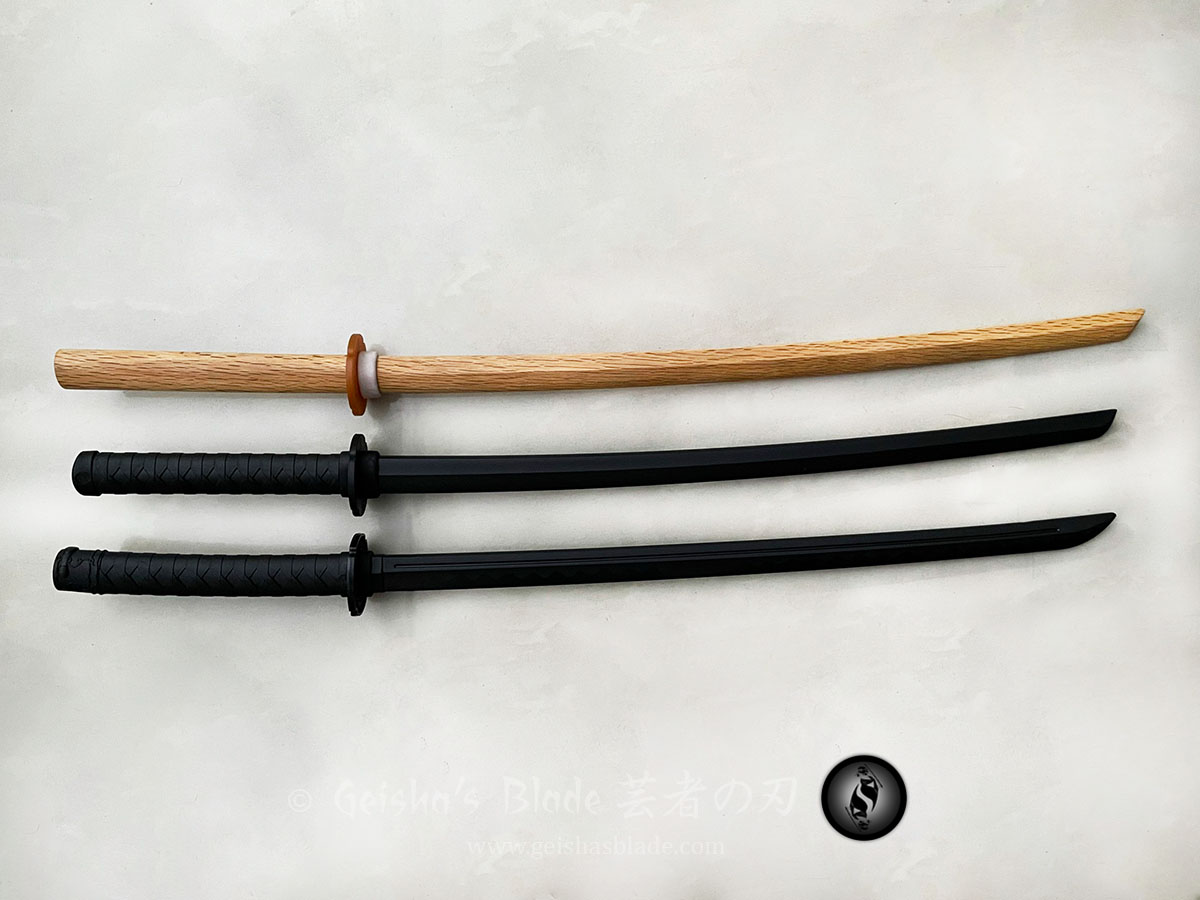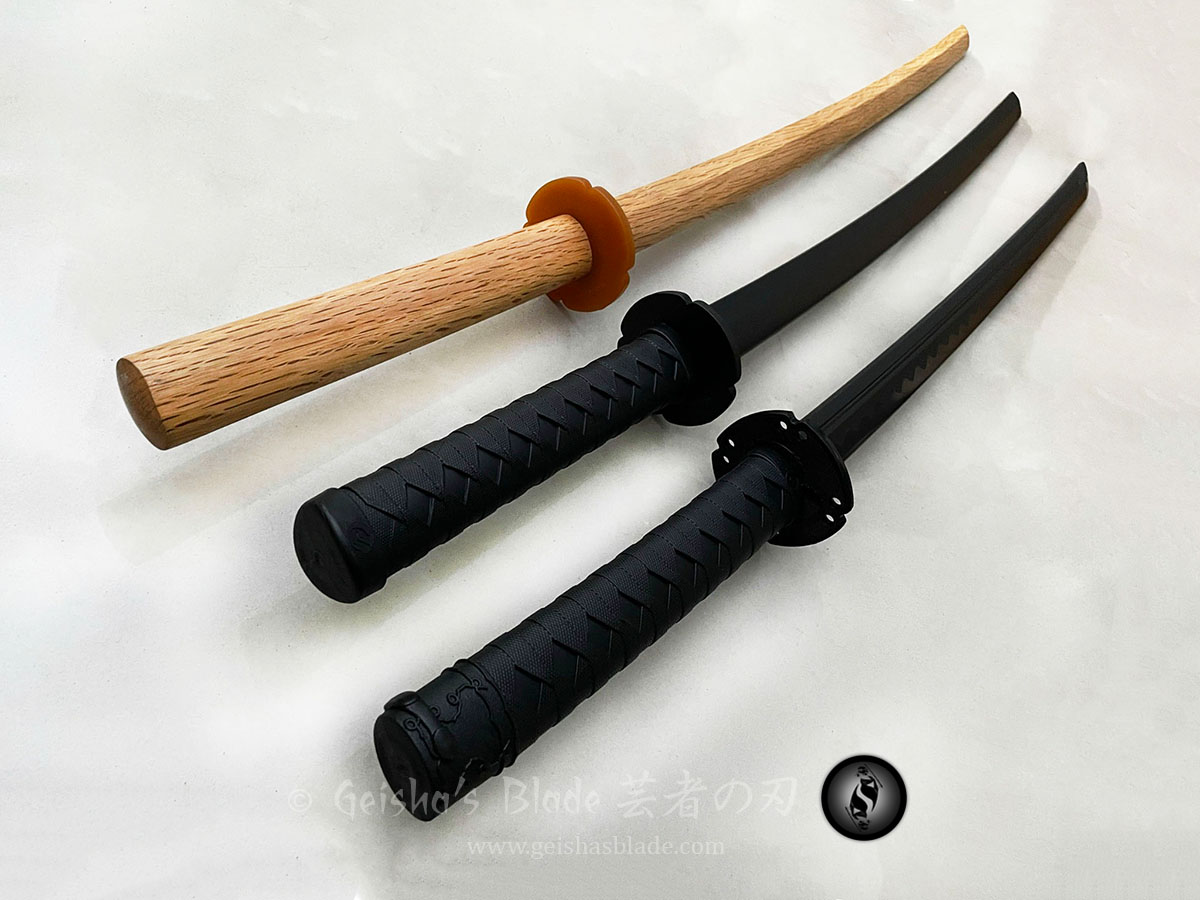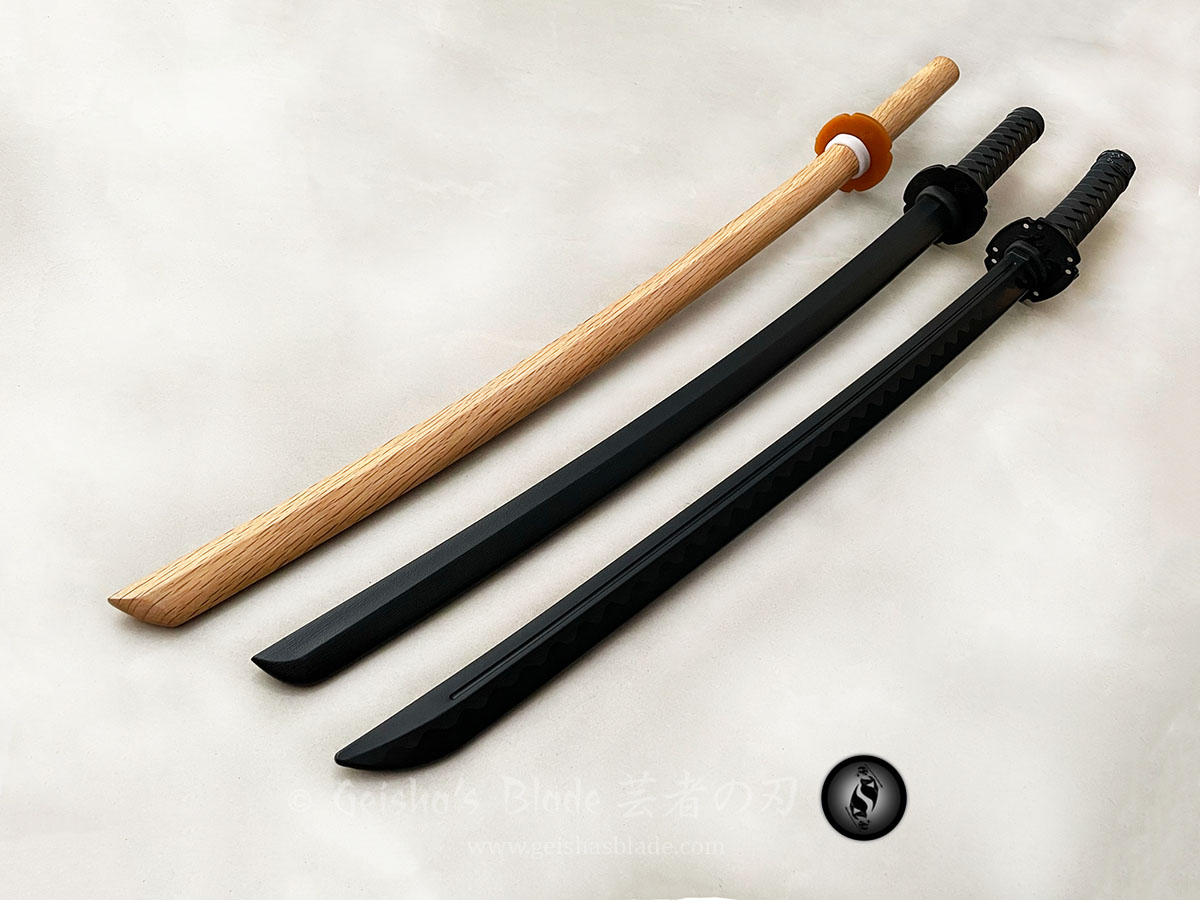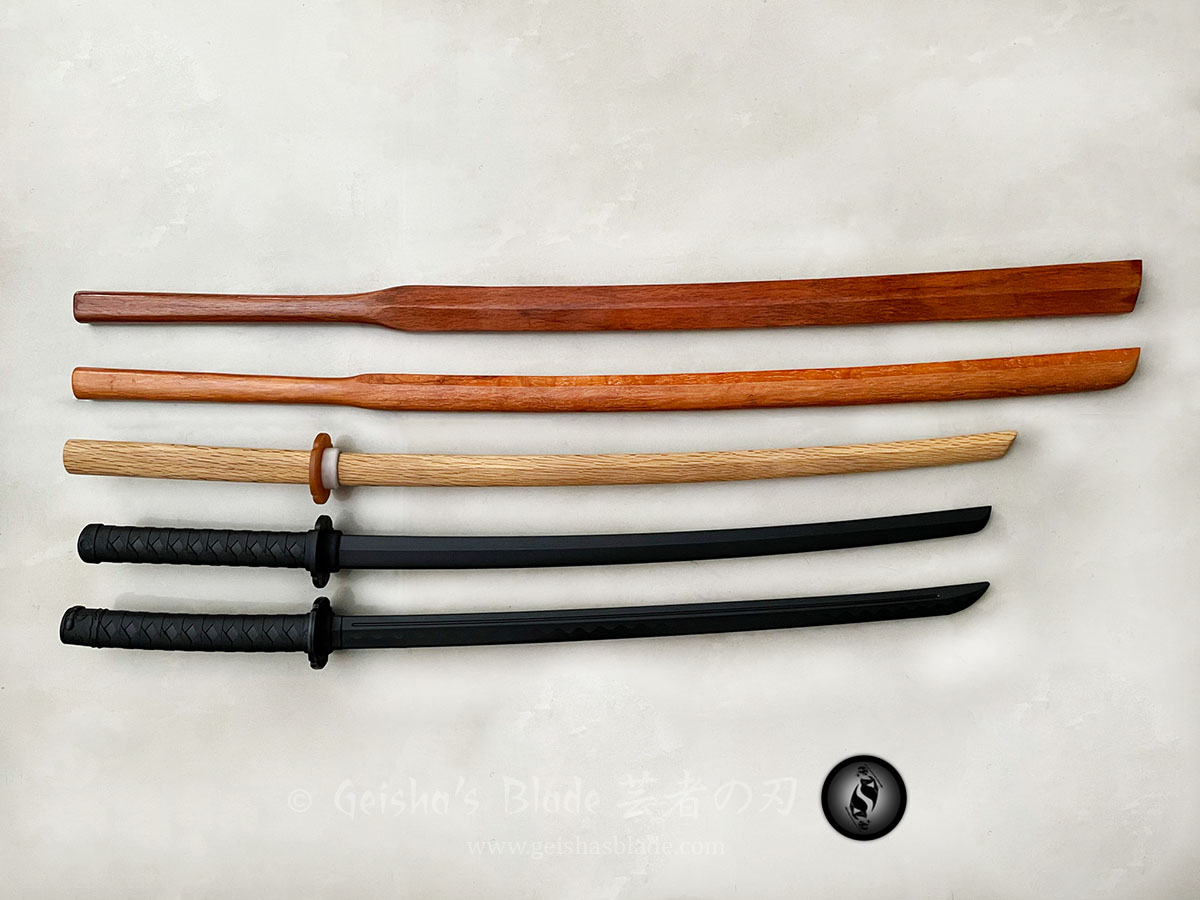Here’s a side by side comparison of our Japanese Red Oak Bokken (Akagashi), Polypropylene Daito (PP Daito), and Polypropylene Katana (PP Katana).
The tsuba on all 3 can be removed and each includes a tsuba-dome (rubber stopper). Their overall length is pretty much the same, though the Akagashi’s blade length is a bit longer. All 3 have a nice blade curvature like a real katana.
Overall length
Akagashi: 40 inches
PP Daito: 38.25 inches
PP Katana: 39 inches
Blade length
Akagashi: 30 inches
PP Daito: 27.75 inches
PP Katana: 27.5 inches
Plastic tsuba: Akagashi (top left), PP Daito (top right), PP Katana (bottom)
Tsuka length
Akagashi: 10 inches
PP Daito: 9.5 inches
PP Katana: 10.25 inches
The tsuka (handle) of the Akagashi and PP Katana Katana has similar length, the tsuka of the PP Daito is shorter among the 3. The tsuka of the PP Daito and PP Katana are molded like a real katana with tsukamaki (handle wrapping), and fittings (fuchi-kashira). The PP Katana has a habaki (blade collar), bohi (groove) and hamon (temper line) on the blade like a real katana.
Even though the handle of the PP Daito is designed like a real katana, it’s blade is designed to look like a bokken. It’s tip is similar to the Akagashi and has a wood grain texture. The tip of the PP Katana is shaped like real katana.
The edge of the Akagashi and PP Daito are both wide and rounded. As for the edge of the PP Katana, it’s also rounded but thinner. The PP Daito is slightly heavier than the PP Katana because its blade has more girth (about 6mm thicker measured at the thickest part of the blade above the tsuba-dome / habaki area).
Weight
Akagashi: varies between 560 grams to 590 grams
PP Daito: approx 505 grams
PP Katana: approx 465 grams
Since the Akagashi is wood, it is stiff. It also has more weight among the 3. The PP Daito and PP Katana are made of polypropylene (a form of plastic), so they’re lighter than the Akagashi and their blades are flexible (like a real katana). Akagashi is a traditional training weapon of Japanese related sword arts, but it won’t last for a very long time because it will get dents and splinters (especially if you hit very hard). Our polypropylene training swords are non-traditional, but they will last for a very long time as they’re almost indestructible. They won’t splinter or get dents even if you hit it with a hammer. Its only weakness is that it will get dented when you hit hard edged corners.
Material
Akagashi: wood
PP Daito: polypropylene
PP Katana: polypropylene
Please watch the impact test we did on our polypropylene swords below:
Impact Test 1
Impact Test 2
Prices
PHP 2,600 Akagashi
https://geishasblade.com/shop/wooden-weapons/japanese-red-oak-bokken/
PHP 3,000 Polypropylene Daito
https://geishasblade.com/shop/bokken/polypropylene-daito/
PHP 3,200 Polypropylene Katana
https://geishasblade.com/shop/bokken/polypropylene-katana/
For contact to contact training, we personally prefer the Akagashi, since we’ve been using one for years already, it’s what we’re used to. But if we’re to choose between the two polypropylene training weapons, we prefer using the PP Daito for contact to contact training since it has more weight. With the PP Katana, we prefer using it for iai (practicing of forms) since it’s lighter.
We hope this helps you decide which is the best training sword for you.
We also have an available plastic saya and it will fit all 3 training swords.
PHP 1,800 Plastic Saya
https://geishasblade.com/shop/accessories/plastic-saya-for-bokken/
Our PP Daito and PP Katana has a short version and plastic saya available as well.
PHP 2,600 Polypropylene Shoto (partner for the PP Daito)
https://geishasblade.com/shop/bokken/polypropylene-shoto/
PHP 2,800 Polypropylene Wakizashi (partner for the PP Katana)
https://geishasblade.com/shop/bokken/polypropylene-katana/
PHP 1,600 Plastic Saya
https://geishasblade.com/shop/accessories/plastic-saya-for-short-bokken/
If you want something heavier to train with, we also have suburito available.
Suburi is a Japanese word for practice swings used in sports such as baseball, tennis, golf, and in martial arts. Outside Japan, the word is used exclusively for repetitive individual cutting exercises used in Japanese martial arts such as kendo, aikido, iaido, and kenjutsu.
A suburito is used for practicing suburi (sword swinging exercises). Compared to a regular bokken, the suburito is designed with a longer, wider, and thicker blade, and heavier weight for muscle strengthening and conditioning, to develop physical power. You can strengthen your arms, shoulder, and other muscles of your upper body. It’s also to improve precision in your way of using the sword.
Our oar style suburito is inspired by the story of Miyamoto Musashi’s oar shaped bokken, which he is said to have carved and used in his legendary duel on Ganryu Island against Sasaki Kojiro.
PHP 3,200 Oar Style Suburito (Kaigata)
Weighs approx 1kg
https://geishasblade.com/shop/wooden-weapons/oar-style-suburito-kaigata/
PHP 3,000 Standard Suburito
Weighs approx 900 grams
https://geishasblade.com/shop/wooden-weapons/standard-suburito/

